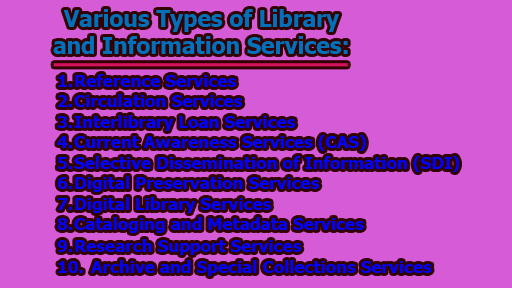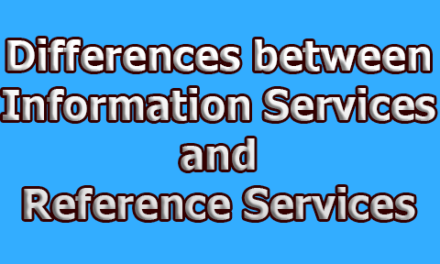Various Types of Library and Information Services:
Libraries and information centers provide a wide range of services to meet the needs of their patrons. Here are some of the most common types of library and information services:
1. Reference Services: Reference services are designed to assist library users in finding the information they need. Librarians provide guidance and support in locating relevant resources, answering research questions, and utilizing various tools and databases effectively. This can include one-on-one consultations, research assistance, and recommendations for further reading or exploration.
2. Circulation Services: Circulation services involve the management of library materials that are loaned out to patrons. This includes tasks such as issuing library cards, checking out and checking in materials, renewing loans, managing holds and reserves, and enforcing loan policies. Circulation services ensure smooth and efficient access to library resources.
3. Interlibrary Loan Services: Interlibrary loan services enable library users to access materials that are not available in their local library by borrowing them from other libraries. Librarians coordinate the borrowing and lending of items between libraries, expanding the range of resources available to users and facilitating information sharing among libraries.
4. Current Awareness Services (CAS): Current Awareness Services keep library users informed about the latest developments in their areas of interest. Librarians curate and disseminate current awareness materials such as newsletters, email alerts, RSS feeds, and social media updates. CAS helps users stay up to date with new research, publications, events, and trends in their fields.
5. Selective Dissemination of Information (SDI): Selective Dissemination of Information involves the proactive delivery of relevant information to library users based on their specified interests and preferences. Librarians use user profiles, subject keywords, and other criteria to identify and share tailored information, ensuring that users receive materials that are most relevant to their needs, even without actively searching for them.
6. Digital Preservation Services: Digital Preservation Services focus on ensuring the long-term accessibility and integrity of digital content. Librarians implement strategies to preserve digital resources, including file formats migration, metadata management, backup and recovery procedures, and digital archiving. These services help safeguard important digital materials for future generations.
7. Digital Library Services: Digital library services involve the management and provision of digital resources. This includes e-books, e-journals, online databases, digital archives, and multimedia materials. Librarians curate and organize digital collections, ensure access to online resources, and provide technical support for digital platforms and tools.
8. Cataloging and Metadata Services: Cataloging and metadata services involve the organization and description of library materials to facilitate their discovery and retrieval. Librarians apply standardized cataloging rules and create metadata, including subject headings, classifications, and keywords, to enhance the accessibility of library resources through catalogs and databases.
9. Children and Youth Services: Children and youth services are tailored to meet the unique needs and interests of young library users. Librarians curate age-appropriate collections, design engaging and educational programs and events, provide assistance with homework and assignments, and promote literacy and a love for reading among children and teenagers.
10. Archive and Special Collections Services: Archive and special collections services focus on the preservation, organization, and access to unique and valuable materials. This includes manuscripts, rare books, photographs, maps, and other archival materials. Librarians and archivists ensure the long-term preservation of these items, create finding aids and catalogs, and facilitate access for researchers and scholars.
11. Research Support Services: Research support services cater to the needs of researchers, academics, and students conducting scholarly investigations. Librarians offer assistance in navigating research databases, identifying relevant sources, developing effective search strategies, and accessing specialized research tools and resources. They also provide guidance on citation management and research data management.
12. Outreach Services: Outreach services aim to extend the reach of library services beyond the physical library building. Librarians engage with the community through partnerships, collaborations, and outreach programs. This can include organizing library events, participating in community fairs, conducting educational workshops, and delivering library materials and services to underserved populations.
13. Information Literacy Instruction: Information literacy instruction programs aim to equip library users with the skills and knowledge needed to effectively find, evaluate, and use information. Librarians offer workshops, training sessions, and instructional materials on topics such as information seeking, critical thinking, source evaluation, and ethical use of information.
14. Electronic Resource Management: Electronic resource management involves the acquisition, licensing, and maintenance of electronic resources, including online databases, e-journals, and e-books. Librarians negotiate licenses with vendors, manage subscriptions, monitor usage statistics, troubleshoot access issues, and ensure seamless access to electronic resources for library users.
15. Preservation and Conservation Services: Preservation and conservation services focus on the care, repair, and preservation of library materials to ensure their long-term availability. Librarians and conservation specialists employ techniques and best practices to prevent damage, undertake restoration work, conduct digitization projects for fragile materials, and implement proper storage and handling procedures.
16. Reader’s Advisory Services: Reader’s advisory services assist library users in selecting books and other materials based on their individual interests, preferences, and reading levels. Librarians provide personalized reading recommendations, maintain reading lists and book displays, and engage with patrons to foster a love for reading and lifelong learning.
17. Audiovisual Services: Audiovisual services encompass the management and provision of audio and visual materials. This includes DVDs, CDs, audiobooks, streaming services, and other multimedia resources. Librarians curate and maintain audiovisual collections, facilitate access to these materials, and offer guidance on their use and enjoyment.
18. Community Information Services: Community information services provide access to local resources, information, and services. Librarians act as a central hub of community information, providing guidance on government services, local organizations, social programs, and events happening in the community. They help connect individuals with the resources they need and promote community engagement and involvement.
In conclusion, the diverse range of library and information services plays a vital role in meeting the needs of library users and fostering access to knowledge and resources. From reference and circulation services to digital library management, outreach initiatives, and specialized support for research and information literacy, libraries serve as information hubs that promote lifelong learning, community engagement, and the preservation of valuable materials. By offering a comprehensive array of services, libraries continue to adapt to the evolving information landscape, ensuring that individuals have access to the information they seek and the resources they need to thrive in an increasingly digital world.
FAQs:
What are library and information services?
Library and information services encompass a wide range of offerings provided by libraries to meet the needs of users and facilitate access to information and resources. These services go beyond traditional book lending and include reference assistance, interlibrary loans, digital library management, cataloging and metadata services, specialized support for research, outreach programs, and more.
Why are reference services important?
Reference services are important because they help users locate information and answer their questions. Librarians provide expert guidance on how to use library resources effectively, offer research strategies, and assist in navigating databases and catalogs. Reference services ensure that library users can access the information they need and make the most of available resources.
What is the role of circulation services in a library?
Circulation services are responsible for the lending and return of library materials. Librarians and library staff manage the circulation desk, issue library cards, check out and check in items, handle holds and reserves, and enforce loan periods and overdue fines. Circulation services ensure the smooth flow of library materials and enable users to borrow and enjoy the resources available.
How does interlibrary loan service work?
Interlibrary loan (ILL) services allow library users to access materials that are not available in their local library by borrowing them from other libraries. Librarians facilitate the borrowing process by coordinating with partner libraries, submitting requests on behalf of users, and arranging for the loaned materials to be delivered to the user’s library. Interlibrary loan services expand the range of resources accessible to users and promote resource sharing among libraries.
What are digital library services?
Digital library services involve the management and provision of digital resources. This includes e-books, e-journals, online databases, digital archives, and multimedia materials. Librarians ensure the seamless access and usability of these resources, often through digital platforms and interfaces. Digital library services support the growing demand for online resources and enable users to access information anytime and anywhere.
What is the purpose of cataloging and metadata services?
Cataloging and metadata services organize and describe library materials to facilitate their discovery and retrieval. Librarians and catalogers assign subject headings, classify items according to a standardized system (e.g., Dewey Decimal Classification or Library of Congress Classification), and create metadata for efficient searching and browsing. These services enhance the accessibility and usability of library collections, making it easier for users to find relevant resources.
How do children and youth services benefit library users?
Children and youth services focus on meeting the informational and recreational needs of young library users. Librarians develop collections of age-appropriate books, organize educational programs, storytelling sessions, reading clubs, and engage in outreach activities to schools and community groups. Children and youth services promote literacy, cultivate a love for reading, and support the educational development of young library users.
What is the significance of archive and special collections services?
Archive and special collections services manage unique and valuable materials that require specialized care and access. Archivists preserve, arrange, and describe historical documents, manuscripts, photographs, rare books, and other archival materials. They ensure their long-term preservation and make them accessible to researchers, supporting the study of history, culture, and other specialized areas.
How do research support services assist library users?
Research support services cater to the needs of researchers, academics, and students conducting scholarly investigations. Librarians provide assistance in literature searches, help users navigate scholarly databases, offer guidance on citation styles, and provide instruction on research data management and copyright compliance. Research support services empower users to conduct effective research and access relevant scholarly resources.
What is the purpose of outreach services in libraries?
Outreach services aim to extend library services beyond the physical library space and reach underserved populations. Librarians collaborate with community organizations, schools, and other institutions to deliver library programs, services, and resources to those who may have limited access. Outreach services promote literacy, information access, and community engagement.
How do information literacy instruction programs benefit library users?
Information literacy instruction programs teach users the skills and knowledge needed to effectively find, evaluate, and use information. Librarians provide instruction on search strategies, critical evaluation of sources, citation practices, and ethical use of information. Information literacy instruction equips users with the tools to navigate the vast amount of information available and become discerning consumers of information.
What are electronic resource management services?
Electronic resource management services involve the acquisition, licensing, and maintenance of electronic resources in libraries. Librarians negotiate licenses with vendors, ensure seamless access to e-books, e-journals, databases, and troubleshoot technical issues related to electronic resources. Electronic resource management ensures that users have access to a wide range of digital materials and resources.
Why are preservation and conservation services important?
Preservation and conservation services aim to ensure the long-term availability and usability of library materials. Librarians and conservation specialists employ techniques to prevent damage, undertake restoration work on fragile items, implement storage and handling procedures, and digitize materials for preservation purposes. Preservation and conservation services protect valuable materials for future generations.
How do reader’s advisory services assist library users?
Reader’s advisory services help library users in selecting books and materials based on their interests and preferences. Librarians provide personalized reading recommendations, maintain reading lists, and engage in conversations with users to understand their reading tastes. Reader’s advisory services promote reading enjoyment, discovery of new authors and genres, and support lifelong learning.
What are audiovisual services in libraries?
Audiovisual services involve the acquisition, organization, and lending of multimedia materials. Librarians manage collections of DVDs, CDs, audiobooks, streaming services, and other audiovisual resources. Audiovisual services cater to the informational and entertainment needs of library users and ensure access to a diverse range of multimedia materials.
How do community information services benefit library users?
Community information services provide users with access to local resources, services, and events. Librarians act as information hubs, offering guidance on government programs, social services, employment opportunities, local organizations, and events happening in the community. Community information services help connect individuals with resources and support community development.

Library Lecturer at Nurul Amin Degree College










